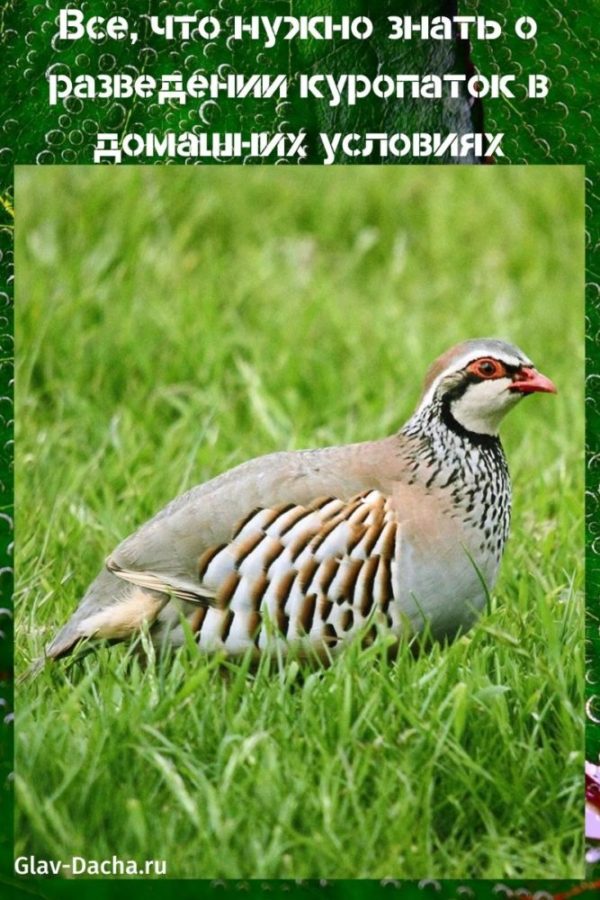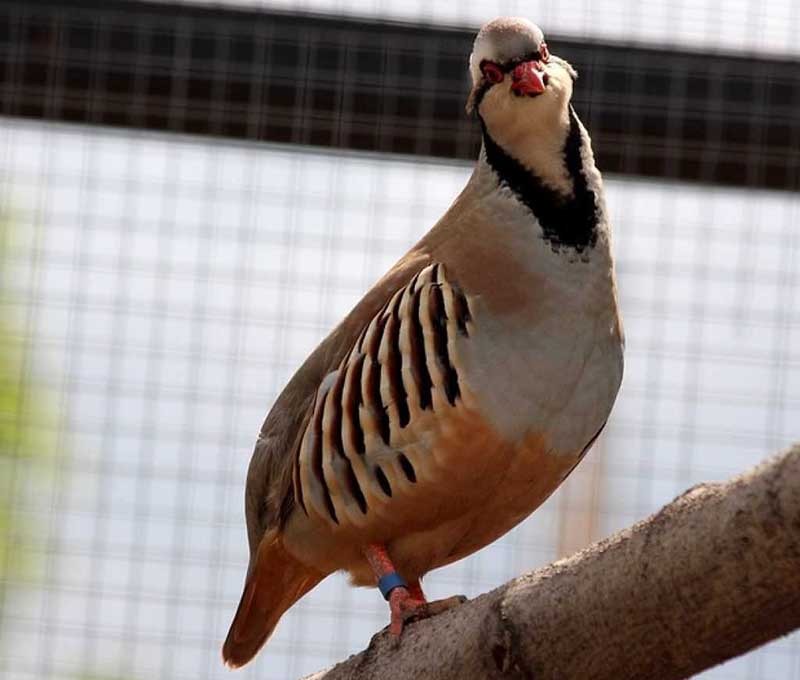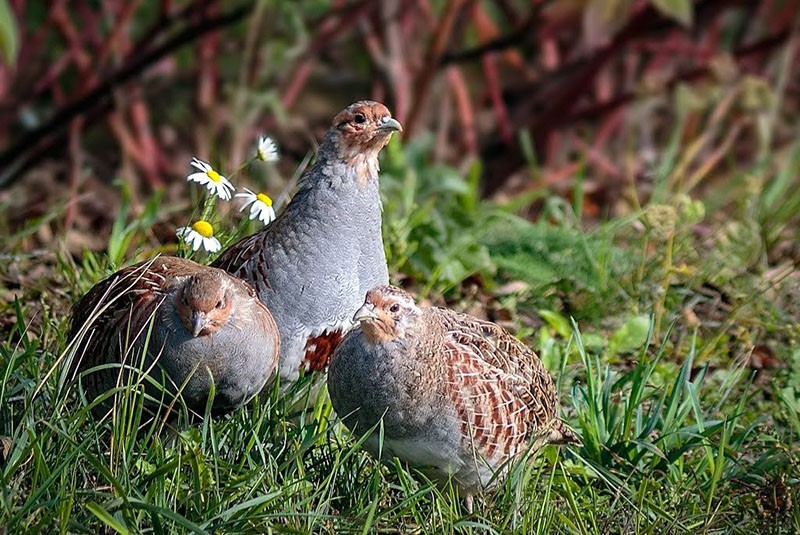Breeding partridges at home: basic tips for keeping
 Breeding partridges at home is a profitable and competitive business, as their meat is considered a delicacy. This game is highly regarded for the delicate taste and nutritional properties of the meat, which is why it is included in the menu of many restaurants. That is why partridges can be bred not only for personal consumption, but also for profit.
Breeding partridges at home is a profitable and competitive business, as their meat is considered a delicacy. This game is highly regarded for the delicate taste and nutritional properties of the meat, which is why it is included in the menu of many restaurants. That is why partridges can be bred not only for personal consumption, but also for profit.
What breeds of partridges are suitable for home breeding

The main varieties include:
- white-tailed;
- white;
- tundra;
- gray;
- keklik.
For home breeding, the latter breed is most suitable. Breeding of the gray partridge has become widespread due to unpretentious feeding, quick adaptation to new habitat conditions, and also the highest egg production among all species of partridges.
Keklik breeding is not widespread. The female can incubate up to 50-60 eggs, but never incubates them. For breeding chicks, incubator... That is why chickpea are most often grown exclusively for aesthetic purposes.
Breeding partridges at home: the main features
 Growing partridges at home is not much different from breeding chickens. The main advantage of these birds is their simplicity and ease of care. They can be kept both in regular chicken coops and in cages.
Growing partridges at home is not much different from breeding chickens. The main advantage of these birds is their simplicity and ease of care. They can be kept both in regular chicken coops and in cages.
Basic rules for growing partridges:
- Temperature regime - the optimal temperature for partridges is considered to be + 19-20 ° С, otherwise their egg production decreases.
- Humidity - it must be maintained within 50-75%. With low air humidity, the productivity of birds decreases.
- Light - too bright illumination makes the partridges aggressive, they begin to peck at each other. The most suitable option is to use lamps with a power of up to 50 W, the duration of daylight hours should be at least 16 hours.
 Keeping partridges at home makes special demands on room ventilation. These birds have a very fast metabolism, therefore, in order to avoid overheating of the body, they constantly need fresh air. At the same time, partridges must be protected from piercing winds and drafts.
Keeping partridges at home makes special demands on room ventilation. These birds have a very fast metabolism, therefore, in order to avoid overheating of the body, they constantly need fresh air. At the same time, partridges must be protected from piercing winds and drafts.
House requirements
 The main difficulty in breeding partridges at home is that this freedom-loving bird is used to living in the wild. It is extremely difficult to accustom her to the cage, because her conditions are not very similar to those. It is enough to let the bird out of the enclosure - and it will simply fly away.
The main difficulty in breeding partridges at home is that this freedom-loving bird is used to living in the wild. It is extremely difficult to accustom her to the cage, because her conditions are not very similar to those. It is enough to let the bird out of the enclosure - and it will simply fly away.
When arranging a poultry house, you need to remember the basic rules:
- the partridge should feel comfortable and spacious, it should be able to fly freely;
- flights for birds should be as safe as possible;
- it is important to protect the house from rodents;
- it is necessary to create conditions that resemble natural as much as possible - to place dry grass, several bushes.
The best option for home conditions is breeding partridges in cages with transfer to a warmed one chicken coop or a poultry house with the onset of winter.
 Almost any dry and warm farm building can be used as a winter poultry house.When arranging it, it must be borne in mind that partridges fly very well and high, therefore, it is better to cover the perimeter of the poultry house with a fine mesh.
Almost any dry and warm farm building can be used as a winter poultry house.When arranging it, it must be borne in mind that partridges fly very well and high, therefore, it is better to cover the perimeter of the poultry house with a fine mesh.
Partridges are extremely fearful, so for the poultry house it is best to choose a place in the far corner of the yard, away from noise and farm animals.
Arrangement of the cell
 When arranging the aviary, it must be borne in mind that it must be spacious enough so that the partridges can fly freely. That is why the height of the cage should be at least 2 m. One partridge should have at least 50-70 cm of the enclosure area.
When arranging the aviary, it must be borne in mind that it must be spacious enough so that the partridges can fly freely. That is why the height of the cage should be at least 2 m. One partridge should have at least 50-70 cm of the enclosure area.
From above and from all sides, the cage is necessarily fenced off with a fine-mesh mesh - best of all, cotton or nylon. The metal net should not be used as it can injure the bird.
For the quick adaptation of partridges and their comfortable stay inside the enclosure, it is necessary to create conditions that are as close as possible to wildlife.
To do this, you can place sheaves of dried grass, hay, several spruce branches, a shed under the roof, under which the birds can take refuge.
Drinkers, nurseries with green grass, feeders, as well as so-called baths are installed in the aviary for partridges. These are containers filled with sand. Birds bathe in it to eliminate parasites in their feathers.
When keeping partridges in a small room, several cages with birds can be arranged in a row, at a distance of about 80-100 cm from each other. They are raised 70-90 cm from the floor or the ground - this height helps to reliably protect the partridges from wind, drafts, dampness and parasites.
Feeding partridges
 The nutrition of partridges should be balanced in all the necessary vitamins and minerals. The "menu" of this bird is not much different from chickens with the only exception - partridges should not be given chicken feed.
The nutrition of partridges should be balanced in all the necessary vitamins and minerals. The "menu" of this bird is not much different from chickens with the only exception - partridges should not be given chicken feed.
What partridges eat:
- chopped barley;
- millet;
- sorghum;
- crushed barley and wheat;
- corn grains;
- oats;
- white cabbage leaves;
- lentils;
- sunflower seeds;
- viburnum berries and rowan;
- meal and cake from oil plants.
Fresh greens are an obligatory part of the partridge's diet. For feeding these birds, lettuce leaves, clover, alfalfa, nettle, dandelion are most suitable. In the winter season, partridges are additionally given crackers from wheat bread, fish oil, cottage cheese with a small percentage of fat.
Also, partridges can be given vegetables, fruits and roots - but finely chopped. Sugar and fodder beets, zucchini, carrots, cucumbers, apples and pears are suitable for feeding.
In addition, the birds are given calcium supplements - crushed eggshells or crushed shell rock.
Feeding mode
 It is recommended to feed partridges twice a day, morning and evening. For these birds, both lack of food and overfeeding are very dangerous. That is why you need to monitor the portion size - no more than 50 g of grain mixture is given for one partridge.
It is recommended to feed partridges twice a day, morning and evening. For these birds, both lack of food and overfeeding are very dangerous. That is why you need to monitor the portion size - no more than 50 g of grain mixture is given for one partridge.
 Feeding chicks is different from that of adult birds. Their peculiarity is that their digestive system continues to form after birth. During the first 5-7 days, the chicks can be given mashed boiled egg yolk. After the specified time has elapsed, a wheat loaf soaked in milk is introduced into the diet of the chicks.
Feeding chicks is different from that of adult birds. Their peculiarity is that their digestive system continues to form after birth. During the first 5-7 days, the chicks can be given mashed boiled egg yolk. After the specified time has elapsed, a wheat loaf soaked in milk is introduced into the diet of the chicks.
Diseases of partridges and the fight against them
When kept in captivity, partridge diseases can develop, one of which is atrophy of the gizzard. The main cause of the disease is the long-term use of mealy feed by birds. To solve this problem, it is imperative to add fine gravel to the food for partridges, which contributes to better digestion of food.
Avitaminosis is an equally common disease of partridges. In the wild, they eat huge amounts of fresh grass, larvae and insects.
For the treatment of beriberi, fresh herbs, ground fish or bone meal should be present in the diet of birds.
If the house is not cleaned regularly, partridges can develop respiratory diseases. The cause is the ammonia fumes emanating from their droppings. It is very important to promptly clean the enclosure and the entire house.
Breeding partridges
 It is better for novice poultry breeders to breed partridges not with hatching eggs, but with several adult birds, which is much easier. They are bought in special nurseries. You can also just catch a few partridges while hunting, but this method has a significant drawback - wild birds are very difficult to take root at home.
It is better for novice poultry breeders to breed partridges not with hatching eggs, but with several adult birds, which is much easier. They are bought in special nurseries. You can also just catch a few partridges while hunting, but this method has a significant drawback - wild birds are very difficult to take root at home.
Partridges must be heterosexual. During the mating period, the partridges are divided into pairs and create a kind of “families”, so their number should be paired.
To breed partridges, they must be transferred to an aviary. This is best done in the spring. First of all, a female is launched into the cage, an hour later a male is allowed to visit her. If the birds remain friendly and calm, they have successfully created their pair. If they start to fight, chase each other, the female did not like the male. In this case, it is replaced.
 When partridges lay eggs depends on the conditions in the enclosure, climate and food. Birds can build their own nest from hay, grass and their own down, or they can be placed in a regular box filled with straw in a cage.
When partridges lay eggs depends on the conditions in the enclosure, climate and food. Birds can build their own nest from hay, grass and their own down, or they can be placed in a regular box filled with straw in a cage.
Partridges are highly productive. In one clutch they can have up to 20-25 eggs. The couple incubates them for 22-25 days, after which chicks emerge from the eggs. For the first 2 weeks, they stay with their mother, after which they are transplanted into a dry and warm aviary.
For small chicks, you need to equip a separate aviary. It should contain dry sand and fresh grass. Water should not be given to chicks, the only exception is long dry weather.
Breeding partridges at home is not particularly difficult, so these birds are great for novice farmers. With minimal costs and simple, easy maintenance, you can very soon get valuable meat for personal consumption or financial gain.